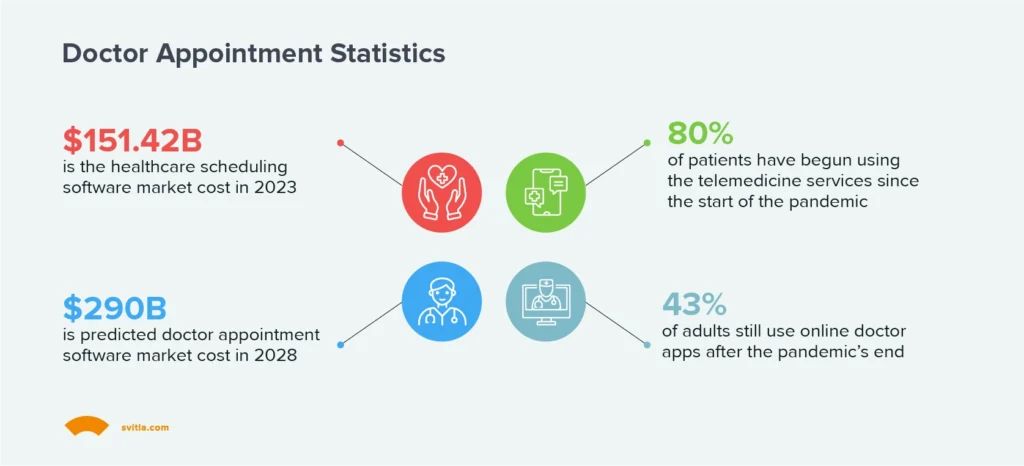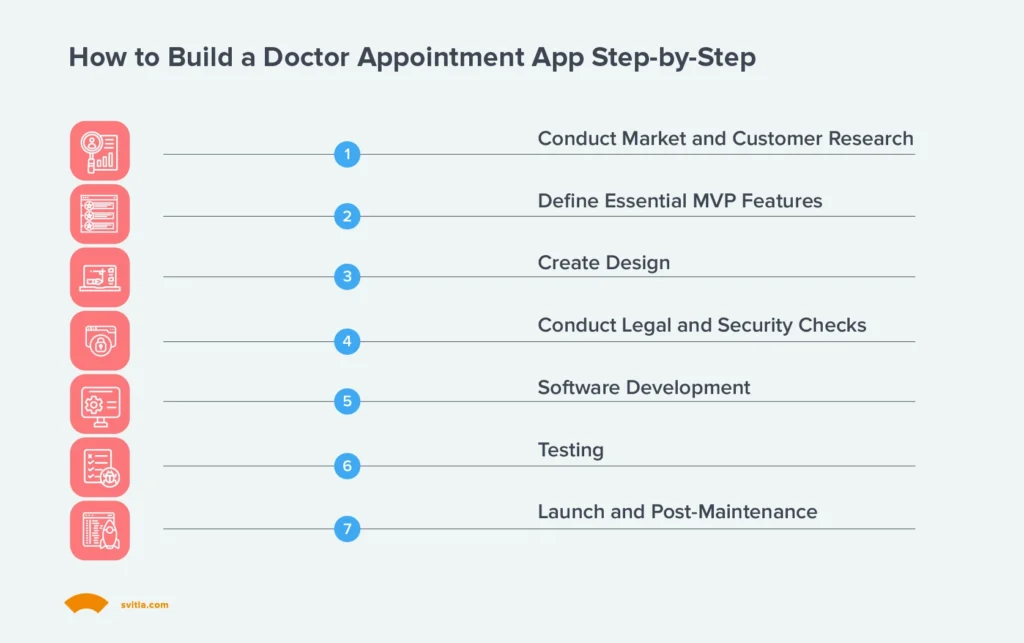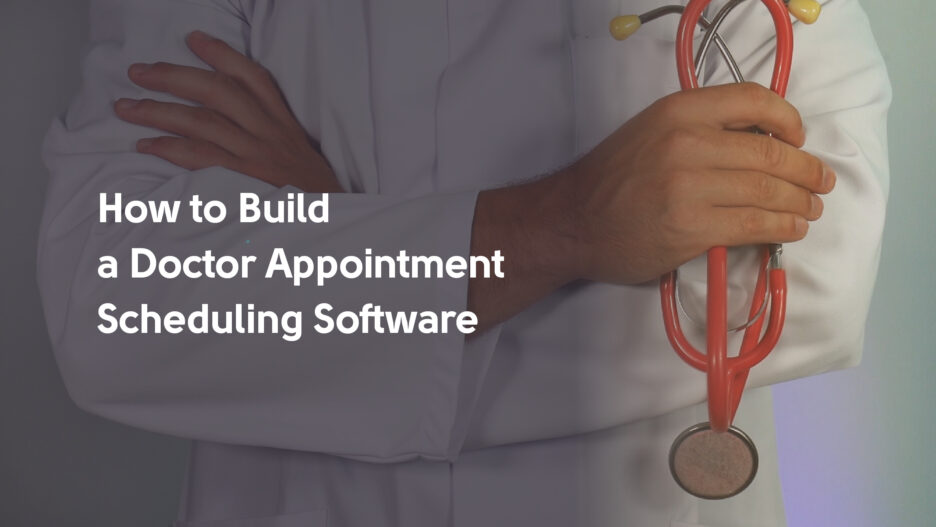In 2023, the healthcare scheduling software systems market costs around $151.42 billion. Yet, experts predict that by 2028, it'll skyrocket to over $290 billion. And you know what pushed this growth into overdrive? The COVID-19 pandemic.
The pandemic made online doctor appointment apps super popular. They started offering useful features like remote consultations, support for multiple languages, and even the ability to link with your travel insurance. These changes have opened up new opportunities for businesses and tech enthusiasts.
Surprisingly, over 80% of people using healthcare appointment apps only began doing so during the pandemic. What's even more surprising is that this trend is sticking around. Even after the pandemic, 43% of adults still use online doctor apps.

So, if you're considering diving into the doctor appointment app development world, you're on the right track. Whether you're starting a new venture in this field or looking to improve hospital services, our article has you covered. We'll share tips, business models, and benchmarking data to guide you in creating a successful doctor appointment booking system.
Key Features for Your Doctor Appointment Application
Every doctor appointment app should include specific features for scheduling online appointments. Let's explore some main ones.
For Patients
- Doctor listings. Patients can easily find doctors by filtering qualifications, specialty, experience, ratings, and location to save time.
- Patient profile. It contains electronic health records and test results, enabling updates and document attachments by patients and doctors.
- Notifications. Reminders for appointments, doctor schedule updates, profile changes, medication reminders, follow-up visits, payment alerts, and symptom checker prompts.
For Doctors
- Doctor’s profile. Details include expertise, location, reviews, and experience, and can be updated by doctors. Some apps allow doctors to share practice updates and health tips.
- Patient database. Holds patient medical history, test results, and prescriptions, enabling quick access for informed decision-making.
Shared Features
- Appointment management. Real-time appointment updates for doctors and easy patient booking, including monitoring specific physicians for available slots.
- Billing and payment. Doctors add bills, review details, and offer popular payment gateways for a seamless experience.
Additional Features
- Map. Aids doctors in planning routes for house visits and for patients to locate healthcare services and hospitals.
- Prescriptions. Speeds up prescription access for doctors, decreasing errors and time spent distributing them to patients.
- Online video conferencing. Telemedicine facilitates remote consultations, which are especially crucial during the pandemic for safety.
- Health monitoring and symptom checker. Allows patients to monitor their health indicators and detect symptoms, aiding them in choosing a suitable doctor.
Key Challenges in Medical Appointment Scheduling Software Development
Healthcare providers aiming to use medical scheduling systems must plan adequately. Before implementing doctor scheduling software, you should consider the possible hurdles ahead.
Ensuring Data Security and User Privacy
Keeping patient information safe on a healthcare scheduling software system is a big deal, not only due to patients’ desire to keep their data secure, but also strict regulations like HIPAA. Here are some essential measures you should take:
- HIPAA compliance. Adhere to the Health Insurance Portability and Accountability Act (HIPAA) standards, ensuring that all patient data is handled in compliance with the law.
- Data encryption. Implement encryption protocols (such as SSL/TLS) to secure data transmission between the user's device and the server. Encrypt sensitive data at rest to protect it from unauthorized access, especially when stored on databases or servers.
- User authentication and authorization. Implement robust authentication mechanisms like multifactor authentication (MFA) to ensure only authorized personnel can access patient data.
Implementing a Payment System
Patients are more likely to use a secure app with different payment options, whether with a credit card or another form of payment like Apple Pay or Klarna, that allows for splitting payments. Ensure your application supports all payment and billing practices without violating privacy policies.
Additionally, stringent measures should be in place to safeguard sensitive financial information. Compliance with relevant privacy policies, such as PCI DSS, is imperative to prevent any compromise of patient financial data. This builds trust among users and ensures the application's adherence to legal and regulatory frameworks.
Designing a User-Friendly UI/UX
For doctor appointment apps to hit their targets, they've got to be easy to use and effortless to get the hang of. The learning curve needs to be as low as possible because people of all ages and varied tech skills will use these apps.
When developing an app, you should also consider its inclusivity and accessibility. This means all users are regarded equally, and all target clients' needs are prioritized, regardless of their physical or cognitive impairments. Although people in the target audience may interact with technology differently, the design must include all the target groups.
How Does Medical Scheduling Software Make Money?
Let’s review five of the most popular monetization strategies for doctor appointment software applications.
Freemium
This model supposes you offer two versions of your app: a free one with basic stuff and a premium one with all the fancy features. The idea is that users will love the free version so much that they'll happily pay for the premium to get even cooler stuff. It's like trying a sample before you buy the whole meal, and it also gets people talking about your app in a good way.
Certified Content
Here's another nifty way to make money: certified content. This one's a gem for apps that connect people and sell useful certified content to care providers. Think of a medical app. Doctors can check out some content for free, like a teaser. But if they want access to top-notch content, they've got to sign up and pay a subscription regularly.
Registration and Subscription Fees
You can charge doctors registration fees if you are about to connect physicians to patients. Yep, doctors pay, not patients. Take Zocdoc, one of the best medical scheduling software, for instance. They charge doctors a monthly fee to stay in the game and let patients book appointments. You can also offer subscription plans. With this, users pick a plan that fits them and drop a fixed fee every month, quarter, or year to keep using the app.
Promotions
Your medical app can be a stage for pleasant discounts and special offers. Think about it – a medical center can offer clients a deal on their next lab test through the app. And app owners can partner with other companies looking to promote their products and services. The key is to figure out what app users like and make those deals happen.
Data Monetization
You can sell the data your app collects, all legal and anonymous. For example, if your app tracks how people's lifestyles change after gastric bypass surgery, that data could be a goldmine for fitness experts, drug companies, or even life insurance companies. Plus, it can be used for various reports and studies to see how our healthcare system is doing.
How to Build a Doctor Appointment Software for Consultants and Clinics
If you're aiming to create a doctor appointment app, here are the essential steps to build a solid medical appointment system:

Step #1. Conduct Market and Customer Research
Check out the market, see what the competition's up to, and ask your target audience what's missing in appointment systems. Figure out what features people use.
Step #2. Define Essential MVP Features
Start with the basics to test your app idea – that’s your MVP. This bare-bones version lets you hit the market faster and get feedback from the early users to pivot further and add priority features. Based on that, you can tweak the app or stop before diving into the big costs.
Step #3. Create Design
Design matters big time. The app needs to be easy to use for both patients and the medical team. It’s all about making the information accessible and navigation a breeze.
Step #4. Conduct Legal and Security Checks
Ensure you follow all the rules and regulations where the application will be used. Health data security is a big deal. Not doing it right could land you serious trouble with fines and a dent in your rep.
Step #5. Software Development
The next step is actual development. At this stage, the engineering team makes the app's front-end look good, sets up the back-end, links up docs databases, figures out how messages work in the app, fires off those push notifications, and handles payments.
Step #6. Testing
Before you launch, make sure you test the app properly. Bugs can mess things up big time, especially in healthcare. You want a stable and secure app to keep the medical community's trust.
Step #7. Launch and Post-Maintenance
The final stage is a product release. The mobile facet involves submitting Android and iOS applications to platforms such as Google Play or the App Store for user download. Once it's out there, it needs regular check-ups — fixing issues and keeping things running smoothly is vital for a great app.
Additionally, server and infrastructure maintenance, user support, and documentation updates provide a reliable and user-friendly experience. At the same time, continuous quality assurance practices help maintain a high standard of software quality.
To Conclude
With technology charging ahead, doctor appointment apps are making healthcare more accessible, reducing wait times, and increasing patient involvement. From setting up appointments on the spot to smooth and secure video chats, they are shaping how healthcare works in the future.
Svitla Systems is here if you’re searching for a solid crew to craft a mobile or web appointment app for doctors. We’ve got a load of experience in healthcare software and can whip up an appointment app that ticks all the boxes — it’s effective, sticks to HIPAA rules, and matches your business goals. Are you ready to start? Do contact our team.




![[Blog cover] How to build a secure DevOps cycle](https://svitla.com/wp-content/uploads/2025/07/Blog-cover-How-to-build-a-secure-DevOps-cycle-560x310.jpg)
